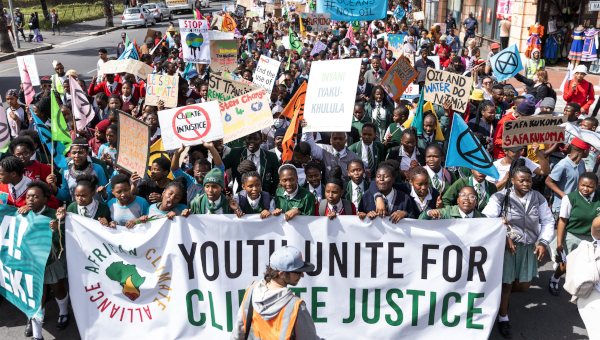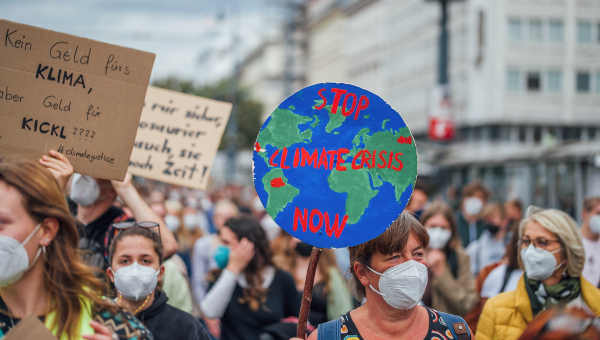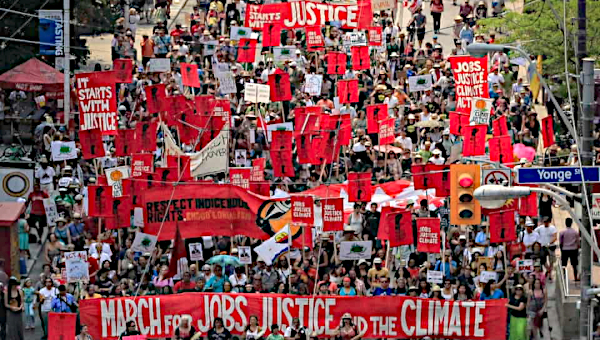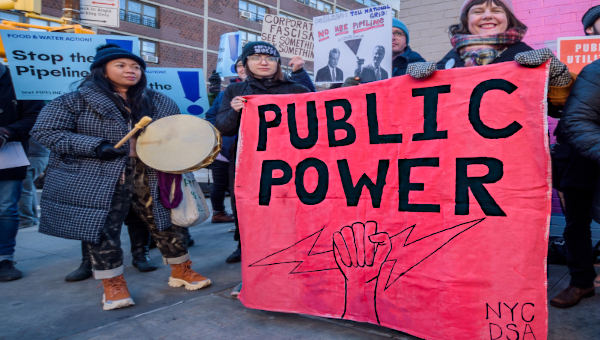Pacific Northwest: The Salmon Fishery, Climate Change and the Eco-System
Salmon have shaped the lives and cultures of people in the Pacific Northwest since ancient times. These migratory fish who return each year from the deep sea to the rivers, where they were born to mate, give birth and die – then nourish the forests’ soil after death – are legendary. They are not just a staple food of the area, but are also intrinsic to the art, songs, mythologies and lifestyles of the Pacific Northwest. Many cultures, which are Indigenous to the land that stretches from Alaska through Northern California, call this zone “Salmon Nation” after the fish, knowing that their own survival and the survival of salmon are inseparable.
Salmon are a keystone species, meaning that the health of salmon can tell scientists about the health of the entire ecosystem – including rivers, oceans, forests, soils and other animal species. And in recent years, salmon have been in steep decline with some salmon species already “on the brink of extinction,” according to the New York Times.
“It’s definitely true in this region [Pacific Northwest] that if the salmon are not well it’s probably because the land and the people are not well, so salmon’s a keystone, or indicator species for that reason,” says Ian Gill, the co-creator of the network called Salmon Nation, based in Vancouver, British Columbia. “Pretty much anybody in the bioregion has some experience [with] salmon, whether it’s catching one, or eating one, or that it’s a symbol in an organization or a sports team they’re part of, or whatever it is. Salmon is everywhere. And we want to reflect that because how we live on the land and live well and treat salmon well affects the makeup of the entire fabric of Salmon Nation.”
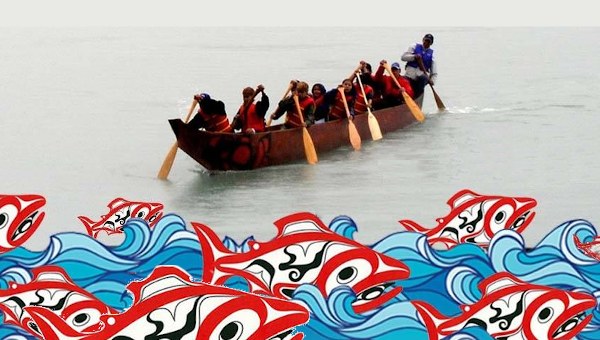
Importance of the Bio-Region
In 2021, Salmon Nation launched a project called Salmon Stories which aims to collect stories that signify the importance of salmon in the lives of people in the bioregion and provide a deeper “understanding that the fight for wild salmon is about much more than fish: it’s about culture, community, livelihood, sustainability, life.”
As part of the Salmon Stories initiative, people interested in sharing salmon stories from their community can apply for a fellowship which pays each fellow $1,000 to collect and record 10 video-based stories, which are 2 to 3 minutes each, that capture “community members sharing a story about salmon.” The project also pays a $50 honorarium to each person interviewed. People also have the option to submit their personal salmon stories on the website. These stories will eventually be launched in the spring of 2022.
“We’re hoping to put thousands of faces to the importance of salmon, and through salmon, the importance of all the other things that need to change about our economic security, capitalist system and ways of living,” Gill says.
Decentralizing Media Content
One goal of the Salmon Stories project is to decentralize the way media content is created, by “uplifting stories” that are not usually heard, in “a non-extractive way.” The project focuses on collecting the video-based stories of people living in “edge communities,” located away from the city centers and are places of typical political sway, in order to diversify the narrative, as explained by Olivia Leigh Nowak, during an online event she hosted for Salmon Nation’s Festival of What Works, which took place in November, and was focused on the Salmon Stories project. Nowak is a filmmaker and media producer who developed the Salmon Stories project and fellowship for Salmon Nation.
Nowak told Independent Media Institute that the idea of the Salmon Stories project is to amplify and support non-experts to create media and be heard – while simultaneously piecing together a tapestry of how both salmon and people are faring across the bioregion.
“Oftentimes [people in media] come into communities and take stories without really knowing what the community needs, or even [without listening] to the community,” she says. “So instead, we started navigating toward the fellowship because we thought that it was a better way for folks within their communities to uplift the things that they want to uplift.”
Gill notes that people who participate in the fellowship are not expected to be trained journalists or filmmakers. It is a storytelling fellowship focused on collecting stories of people that come from their heart.
Nowak adds that there are no barriers to the fellowship application. “We’re getting a lot of women – and a lot of Indigenous women – because on the application it says that there is no requirement for you to have experience with interviewing or filmmaking,” she says. “It’s literally: if you have a phone with a camera and you want to engage with your community and hear what your community has to say about salmon, then you’re on board. And this [fellowship] has started to create a community of creators that have a similar mindset around caring for their ecosystems and the places that they live.”
At the Salmon Stories event during the Festival of What Works, one fellow named Clea Schooner, who is from the Heiltsuk First Nation from Bella Bella, British Columbia, shared why she decided to participate in the storytelling project. “I saw the opportunity to let my people’s voices be heard,” she said in the video recorded event. “We have genuine brilliance in my community. Not in law degrees or doctorates, although some of our community members have those. I am not talking about colonial academic brilliance. I am talking about traditional brilliance: net menders, carvers, cedar weavers and fishermen (or women or fisher-humans). Those voices deserve recognition. How remarkably proud I am to come from such a wealth of knowledge, gifts and hard work this community has to offer. This series is my love language to my people.”
Gill says that the typical narratives around salmon and the state of the bioregion are shaped by technically-focused experts – whether that is the narrative in fisheries management, fisheries conservation, watershed restoration or elsewhere. In turn, this expert narrative is the one the government agencies tend to hear, rather than relying on the stories of wider constituencies. According to Gill, these expert opinions provide a limited scope of understanding relating to the reality in the region. People living at the edges – geographically, economically and culturally – have often expanded and accelerated understandings of the challenges the region as a whole is bound to face, he says. For this reason, the Salmon Stories project is focused on “edge communities.”
“An edge community is where [legislators and politicians] don’t necessarily see power and therefore they feel they can ignore those communities,” Gill says. “Often they’re rural and they’re Indigenous in this part of the world [Pacific Northwest]. Often they’re at the geographic edges, but not always. [These edge communities] are at the intellectual edges, the economic edges. … There are a lot of people living in rural communities – they can even be large rural towns and rural cities – who just feel completely underserved and under-acknowledged by centers of power, state capitals or big cities where money and technology tend to aggregate. Edge communities are often resource-constrained as well.”
And, these communities tend to be more severely impacted by climate change, so often people from edge communities can be more radicalized toward change – especially relating to the impacts of the current global climate disaster, Gill says.
“Here in British Columbia, as you probably know, we’ve had these massive floods. Roads [have been] washed out, people [have been] cut off, [and have died] in mudslides and everything,” he says. “We’re now into these cycles where people are having to live with these realities. These are communities that are actually confronting climate change right now. They’re not [living] in a well-drained city, they’re in a place where their actual lives and livelihoods are endangered by the consequences of climate change. Just look at some of the communities in Alaska [that have been affected by climate change]. As the ice is melting and sea level is rising, whole communities are just buckling. Houses are washing into the ocean.”
However, he says, people in communities like these are oftentimes voiceless.
“You’re not [getting a seat] at the table unless you have expertise, and only more recently is Indigenous knowledge finally being recognized as a form of expertise that’s just as important as hard science. So, the table has expanded a little bit, but it doesn’t actually include the multifaceted nature of how salmon affects people’s lives and touches people,” Gill says.
Gill notes that Salmon Nation is not a salmon conservation organization, but is instead interested in salmon as an avatar or symbol of community and ecosystem health in all its facets across the bioregion.
Each person with a Salmon Stories fellowship is tasked with collecting 10 video-based stories within their circles and uploading them to a shared Google document. The eventual goal is to create an archive of salmon stories that will encompass the significant moment that people in the bioregion are living in.
“With climate change and all that’s going on with salmon habitat degradation, we’re hoping [that Salmon Stories] will become almost [like a] historical record of people and their efforts to rebuild and regenerate their economies around what’s good for salmon,” Gill says. “It might end up being a sad archive, if 50 years from now people look back on this and say, ‘Wow, people were talking about wild salmon. That must’ve been a thing.’ Either way, I think it’s important to find a way to build a fabric of stories that we can’t look away from. We need to be able to look at the fact that this is one of the most important moments in the human experiment on Earth.”
Nowak says the breadth of stories captured thus far is already striking.
“It’s incredible, some of the people [who] sent their applications [for fellowships] and who [want to] share their stories,” she says. For example, one salmon story is by a woman from the Yurok Tribe, living in a rural area, who is speaking from inside of her smokehouse, smoking salmon, [while] her children around her [are] playing with her phone, and she talks about how she never gets to share her voice and her stories.
“[All of us involved in the Salmon Stories project] definitely wanted to make sure that [these] were the people that were coming into the fellowship because we want to rattle the dominant narrative,” she says. “We’re looking for diversity in voices, mostly outside of the [city and urban] centers.”
Gifting Economy
Salmon Nation does not retain exclusive ownership over the videos collected for the Salmon Stories project. The fellows who capture the stories may use them however they want into the future, also, these stories may be used in supportive campaign initiatives working to protect and restore the bioregion – and the person telling the salmon story must first consent before their story is used.
“Before the [Festival of What Works], we were able to use some of the salmon stories to push really awesome initiatives around saving wild salmon, or even just caring for ecosystems,” Nowak says. “We connect the storyteller and the organization, and the storyteller has to give consent for their story to be used – and [also] gets compensation. We’re just housing all these stories, in a place where organizations that have aligned values can potentially tap in… if they need content around communities hearing salmon stories, and stories that are personal and from the heart.”
She says these kinds of stories seem to be pushing the narrative surrounding the integral connection between the people of the bioregion and salmon more successfully than simply talking about data and science.
“By getting personal, we get political,” Nowak says. “People are really interested in using these stories for their campaigns, so we want to make sure that the storytellers are compensated… we also [want to] make sure that the storyteller has rights to their story. We don’t want to own or claim anything. We’re here just to make sure that we’re uplifting voices. If we can help make those voices go even further and louder, great.”
For example, several salmon stories debuted at COP26 in Glasgow, which concluded on November 13. At artist Joseph Rossano’s Salmon School – full of glass salmon sculptures that reflected people’s faces in the bodies of salmon as they walked by – several of the salmon stories shared by Indigenous people, collected by fellows, were played on a video screen next to the display.
“And the storytellers were able to get paid and compensated by the Salmon School, which was really cool,” Nowak says.
Gill says that those involved with the Salmon Stories project, want the stories to be a shared resource that simultaneously values the storyteller, while supporting those people who are working to restore salmon and those they support in the bioregion and beyond.
“This is part of what we [at Salmon Nation] consider to be our contribution to a gift exchange economy,” he says. “We want anybody who has the right intention to be able to come and draw on the story resources that suit them, and supplement the communications work that organizations are doing all over the place…”
“What we’re trying to help people understand is what we are, and how we live [in the Pacific Northwest], is [a] story. We are comprised of all these stories, and [these stories matter]. The narrative that we’re trying to create at Salmon Nation, around living well in place, is highly related to listening to new and different stories from people who wouldn’t normally be heard in mainstream [media], or even non-mainstream media,” Gill says. •
This article was produced by Local Peace Economy, a project of the Independent Media Institute.


